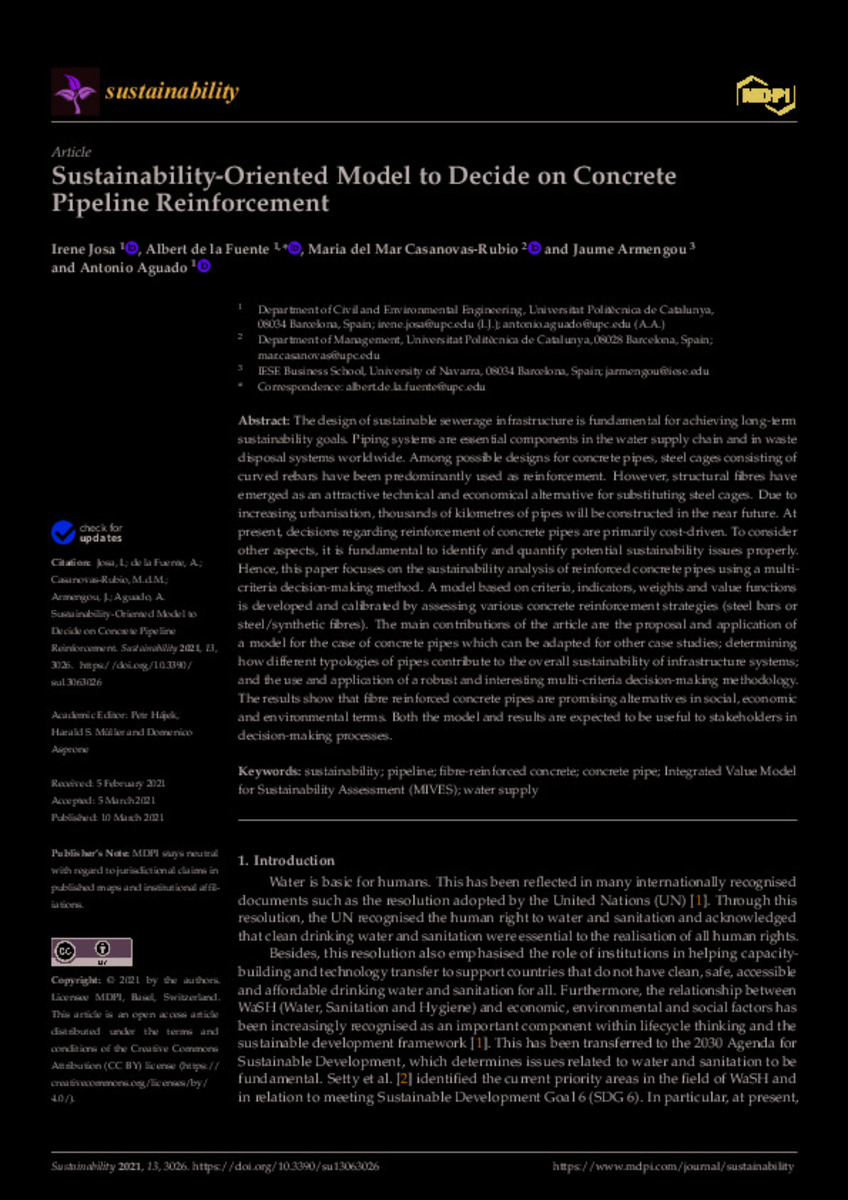Full metadata record
| DC Field | Value | Language |
|---|---|---|
| dc.creator | Josa, I. (Irene) | - |
| dc.creator | Fuente, A. (Albert) de la | - |
| dc.creator | Casanovas-Rubio, M.M. (María del Mar) | - |
| dc.creator | Armengou, J. (Jaume) | - |
| dc.creator | Aguado, A. (Antonio) | - |
| dc.date.accessioned | 2021-03-12T10:10:11Z | - |
| dc.date.available | 2021-03-12T10:10:11Z | - |
| dc.date.issued | 2021-03-10 | - |
| dc.identifier.citation | Josa, I. (Irene); Fuente, A. (Albert) de la; Casanovas-Rubio, M.M. (María del Mar); et al. "Sustainability-oriented model to decide on concrete pipeline reinforcement". Sustainability. 13 (6), 2021-03-10, 1 - 25 | es |
| dc.identifier.issn | 2071-1050 | - |
| dc.identifier.uri | https://hdl.handle.net/10171/60169 | - |
| dc.description.abstract | The design of sustainable sewerage infrastructure is fundamental for achieving long-term sustainability goals. Piping systems are essential components in the water supply chain and in waste disposal systems worldwide. Among possible designs for concrete pipes, steel cages consisting of curved rebars have been predominantly used as reinforcement. However, structural fibres have emerged as an attractive technical and economical alternative for substituting steel cages. Due to increasing urbanisation, thousands of kilometres of pipes will be constructed in the near future. At present, decisions regarding reinforcement of concrete pipes are primarily cost-driven. To consider other aspects, it is fundamental to identify and quantify potential sustainability issues properly. Hence, this paper focuses on the sustainability analysis of reinforced concrete pipes using a multicriteria decision-making method. A model based on criteria, indicators, weights and value functions is developed and calibrated by assessing various concrete reinforcement strategies (steel bars or steel/synthetic fibres). The main contributions of the article are the proposal and application of a model for the case of concrete pipes which can be adapted for other case studies; determining how different typologies of pipes contribute to the overall sustainability of infrastructure systems; and the use and application of a robust and interesting multi-criteria decision-making methodology. The results show that fibre reinforced concrete pipes are promising alternatives in social, economic and environmental terms. Both the model and results are expected to be useful to stakeholders in decision-making processes. | es_ES |
| dc.language.iso | eng | es_ES |
| dc.publisher | MDPI | es_ES |
| dc.rights | info:eu-repo/semantics/openAccess | es_ES |
| dc.subject | Sostenibilidad | es_ES |
| dc.subject | Sustainability | es_ES |
| dc.subject | Conducción | es_ES |
| dc.subject | Pipeline | es_ES |
| dc.subject | Hormigón de fibras | es_ES |
| dc.subject | Fibre-reinforced concrete | es_ES |
| dc.subject | Tubería de hormigón | es_ES |
| dc.subject | Concrete pipe | es_ES |
| dc.subject | Modelo Integrado de Valor para una Evaluación Sostenible (MIVES) | es_ES |
| dc.subject | Integrated Value Model for Sustainability Assessment (MIVES) | es_ES |
| dc.subject | Abastecimiento de agua | es_ES |
| dc.subject | Water supply | es_ES |
| dc.title | Sustainability-oriented model to decide on concrete pipeline reinforcement | es_ES |
| dc.type | info:eu-repo/semantics/article | es_ES |
| dc.relation.publisherversion | https://bit.ly/30xEwQN | es_ES |
| dc.publisher.place | Basilea | es_ES |
| dc.description.note | CC BY 4.0 | es_ES |
| dc.editorial.note | MDPI stays neutral with regard to jurisdictional claims in published maps and institutional affiliations | es_ES |
| dc.identifier.doi | https://doi.org/10.3390/su13063026 | - |
| dadun.citation.endingPage | 25 | es_ES |
| dadun.citation.number | 6 | es_ES |
| dadun.citation.publicationName | Sustainability | es_ES |
| dadun.citation.startingPage | 1 | es_ES |
| dadun.citation.volume | 13 | es_ES |
Files in This Item:
Statistics and impact
Items in Dadun are protected by copyright, with all rights reserved, unless otherwise indicated.






